Pest Info
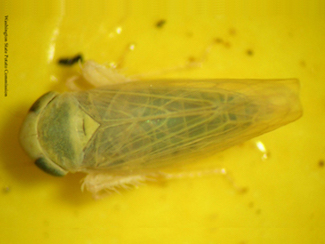
Beet leafhopper
Credits Andy Jensen, NW Potato Consortium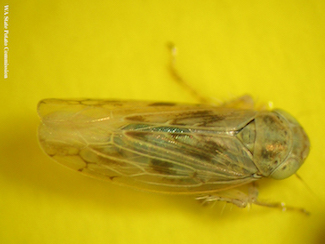
Beet leafhopper
Credits Andy Jensen, NW Potato Consortium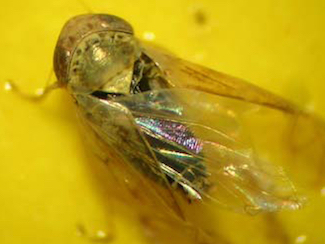
Beet leafhopper
Credits Andy Jensen, NW Potato Consortium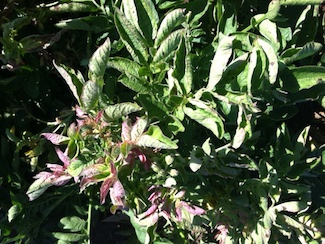
Purple Top
Credits Carrie Wohleb, Washington State UniversityBeet leafhoppers are a transient pest of potato. However, BLH transmits BLTVA, a phytoplasma that causes purple top disease. The preference of BLH for non-potato hosts usually prevents major damage to potato fields, and damage typically occurs near field edges (larger populations can damage entire fields, however). In the Columbia Basin, the first generation of BLH usually migrates towards potato fields in late May and early June, with a peak flight in late June. Yellow sticky traps placed near potato fields are one way to monitor BLH. Information about setting up traps and identifying BLH can be found in the article "Beet Leafhopper Monitoring with Yellow Sticky Cards" . Treatment thresholds based on BLH numbers on traps have not been established, but we know that the risk of infection increases as BLH populations become large. If the numbers on traps build up to 40 or more BLH per week, then it is probably time to be concerned.
Management recommendations. Eliminating weeds (wild mustards, Russian thistle, kochia) around potatoes can reduce populations of BLH. However, weed control should be carefully timed, as removing weeds when potato crops are newly emerged can cause BLH to move into potato fields. Growers at risk from purple top may select cultivars that are less susceptible (Ranger, Umatilla, and Norkotah are considered highly susceptible; Russet Burbank is susceptible; and Alturas and Shepody are moderately susceptible).
A number of insecticides are labeled for control of BLH in potatoes. Systemic at-planting insecticides, especially those with longer residual activity applied at the maximum allowed rate, have been shown to provide some early season control of BLH. Results may vary depending on the product used, application rate, soil and environmental conditions, and insect pressure. Foliar insecticides may also be used to control BLH. These are usually applied in May, June, and sometimes July. Insecticides with long residual activity (10-14 days) are recommended, since two applications can provide almost a month of control. Insecticides with short residual activity are probably not cost-effective, since they would require multiple applications.
For more information about managing BLH, visit IPM Guidelines for Insects and Mites in ID, OR, and WA Potatoes .
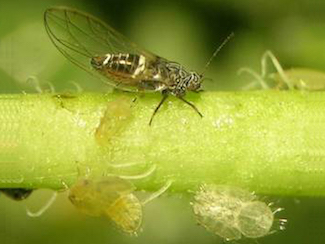
Psyllid Adult and Nymphs
Credits Andy Jensen, NW Potato Consortium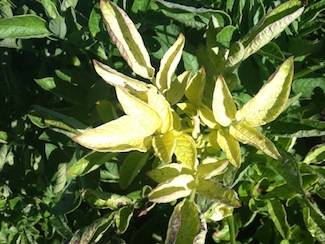
Psyllid Yellows
Credits Carrie Wohleb, Washington State University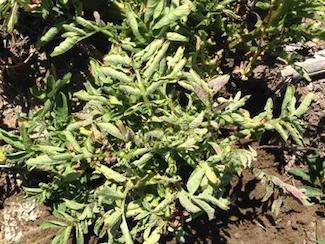
Zebra Chip
Credits Tim Waters, WSU Extension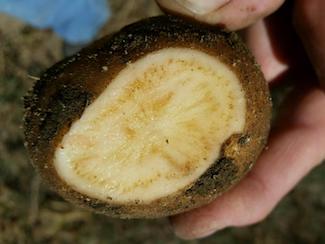
Zebra Chip
Credits Tim Waters, WSU ExtensionPotato psyllids can transmit a bacterium (Candidatus Liberibacter solanacearum) to potatoes that causes zebra chip disease (ZC). This disease reduces both yield and tuber quality and has led to serious economic losses. ZC was first detected in potatoes in the Columbia Basin in 2011. Potato psyllid feeding can also cause psyllid yellows, which can reduce yields and tuber quality. Potato psyllids usually start to move into potatoes in May or June. Yellow sticky cards can be used to detect psyllid migration into an area. The cards should be placed inside the field, very near the field edge, and right above the canopy. We recommend using the AlphaScents brand sticky cards, because they are stickier than most sticky cards and hold up under irrigation. It is best to have at least four yellow sticky cards around the field. For more information about trapping psyllids, read "Psyllid Monitoring with Yellow Sticky Cards". Other life stages of the psyllid can be found by collecting several leaves (mid-plant) from the outside rows of the field, and then scanning the underside (with a hand-lens) for the tiny nymphs and eggs.
Management recommendations. Management of psyllids relies on preventing populations from establishing in potato fields. One way to manage psyllids is to start with a systemic insecticide at planting or at layby, followed by foliar insecticide applications. The residual effect of at-planting neonicotinoids will depend on the time and rate of the application and the rate of plant growth. If only foliar insecticides are used, then it is recommended that applications begin upon first detection of potato psyllids in your area.
For more information about psyllids, including insect identification, monitoring, and control recommendations, read IPM Guidelines for Insects and Mites in ID, OR, and WA Potatoes.
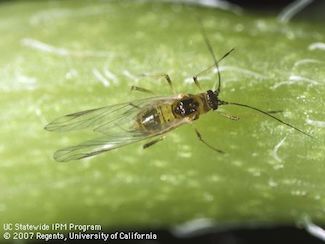
Winged morph
Credits Andy Jensen, NW Potato Consortium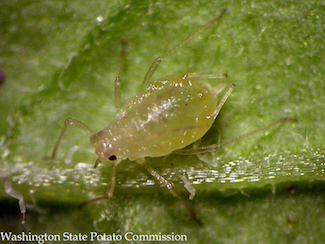
Wingless morph
Credits Andy Jensen, NW Potato Consortium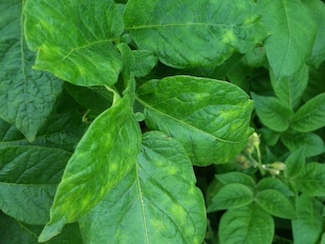
Potato virus Y (PVY)
Credits Carrie Wohleb, Washington State University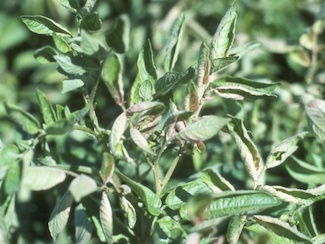
Potato Leafroll Virus (PLRV)
Credits Gary Pelter, retired WSU ExtensionAphids can transmit several important potato viruses, especially potato leafroll virus (PLRV) and potato virus Y (PVY). Green peach aphids are the most important vector of PLRV, which can result in significant yield and tuber quality losses. PLRV causes net necrosis in some cultivars, an unacceptable tuber defect in processing potatoes. PVY can also result in significant yield losses, and some strains of the virus cause tuber defects. The tuber necrotic strains of PVY are becoming more prevalent in the PNW. In addition to spreading viruses, green peach aphids can cause significant feeding-damage that ends in the early senescence of plant foliage.
Management recommendations. The first step in preventing the spread of potato viruses by aphids is to plant certified seed potatoes. Early recognition and control of aphids is the next-best tactic in limiting spread of potato viruses, especially PLRV. Growers should monitor fields for aphids at least weekly to catch infestations early, as large infestations can be difficult to control even with multiple insecticide applications.
For more information about aphids, including insect identification, monitoring, and control recommendations, read IPM Guidelines for Insects and Mites in ID, OR, and WA Potatoes.
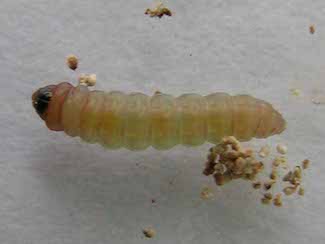
Potato tuberworm larva
Credits Andy Jensen, NW Potato Consortium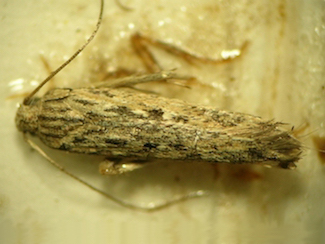
Potato tuberworm adult
Credits Andy Jensen, NW Potato Consortium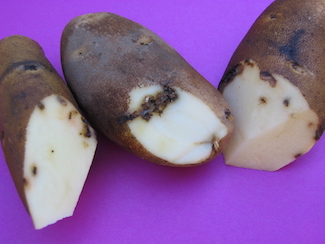
Damage on potatoes
Credits Gary Pelter, retired WSU Extension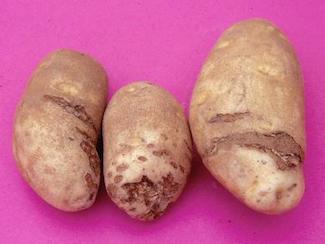
Damage on potatoes
Credits Gary Pelter, retired WSU ExtensionPotato tuberworm larvae feed on tubers, causing damage that renders them unmarketable. Potato growers with fields south of Connell, WA are recommended to pay close attention to regional trapping data, and should deploy pheromone traps. Infestations of PTW are highly localized, and it is risky to conclude too much from traps that may be several miles away. Information about setting up traps and identifying PTW moths can be found in the article, "Tuberworm Monitoring with Pheromone Traps" . Trap counts from mid-season to harvest are particularly important to watch. Pre-harvest control measures may be warranted in fields where PTW moths in pheromone traps are found to be increasing every week, especially in August-October.
Management recommendations. It can be very important to manage PTW in the weeks leading up to harvest. Most of the feeding-injury to tubers occurs after vine kill or senescence when the larvae move from the foliage to the tubers. Damage to tubers increases the longer the potatoes stay in the field under dead vines. Insecticide treatments beginning 4-8 weeks before harvest have been shown to reduce damage. It is very important to consider the pre-harvest interval when selecting a product to apply. Cultural practices that reduce tuberworm damage can be effective and include: (1) eliminating cull piles and volunteers; (2) minimizing the time between vine kill or senescence and harvest or harvest under green vines; (3) maintaining soil moisture after vine kill to prevent soil cracking; and (4) maintaining more than 2-inches of soil over tubers.
For more information about PTW, including insect identification, monitoring, and control recommendations, read IPM Guidelines for Insects and Mites in ID, OR, and WA Potatoes.
INSECTICIDE USE & EFFICACY CONSIDERATIONS: Managing insect pests in Columbia Basin potatoes can be challenging because so many pests can overlap and insecticides vary in what they control. The table below is a quick reference to insecticides labeled for use on potatoes. It is not a complete list and is not meant as an endorsement of these products.
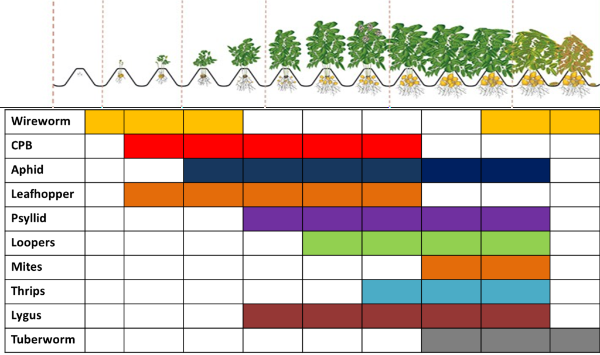
| Trade Name1 | Active Ingredient | IRAC Group3 | Colorado Potato Beetle | Beet Leafhopper | Psyllid | Aphid | Looper Cutworm Armyworm | Mites | Potato Tuberworm | Thrips | Lygus |
|---|---|---|---|---|---|---|---|---|---|---|---|
| Lannate (SP, LV) | methomyl | 1A | G* | P | G (A)* | G | G | G | G* | G* | |
| Vydate C-LV | oxamyl | 1A | G | G | S | G | G* | S | G* | G* | |
| Dimethoate (and others) | dimethoate | 1B | G (A)* | G | |||||||
| Imidan 70-W AG | phosmet | 1B | G | G | G* | G | |||||
| pyrethroids2 | various | 3 | G | G | G (NA) | G | G | ||||
| Scorpion 35SL, Venom | dinotefuran | 4A | G | G | G (ENA) | ||||||
| Platinum | thiamethoxam | 4A | G | G | G (ENA) | G | |||||
| Cruiser 5FS | thiamethoxam | 4A | G | G | G (ENA) | G | |||||
| Belay | clothianidin | 4A | G | G | G (ENA)* | G | |||||
| Admire Pro | imidacloprid | 4A | G | G | G (ENA) | G | |||||
| Assail (30SG, 70WP) | acetamiprid | 4A | G | G | G (A)* | G | |||||
| Actara | thiamethoxam | 4A | G | G | G | ||||||
| Transform WG | sulfoxaflor | 4C | G | G (NA) | G | G* | |||||
| Sivanto | flupyradifurone | 4D | G | G | G (NA) | G | G* | ||||
| Delegate WG | spinosad | 5 | G | G (N)* | G | G* | G | G* | |||
| Entrust | spinosad | 5 | G | G (N)* | G | G* | G | G* | |||
| Radiant SC | spinetoram | 5 | G | G (N)* | G | G | G | G* | |||
| Agri-Mek SC (and others) | abamectin | 6 | G | G (NA) | G | G | G* | ||||
| Fulfill | pymetrozine | 9B | G (NA)* | G | |||||||
| Onager Optek, Hexamit | hexythizox | 10A | G (EN)* | G | |||||||
| Comite | propargite | 12C | G | ||||||||
| Rimon 0.83 EC | novaluron | 15 | G (L) | G (N)* | G (L) | G (L) | G* | G (N)* | |||
| Trigard | cyromazine | 17 | G (L) | ||||||||
| Torac | tolfenpyrad | 21A | G | G (NA) | G | G | |||||
| Miteus | fenpyroximate | 21A | G | G | G | ||||||
| Avaunt | indoxacarb | 22 | G | G | |||||||
| Movento | spirotetramat | 23 | G (EN) | G | S | G | |||||
| Oberon (2SC, 4SC) | spiromesifen | 23 | G (EN) | G | |||||||
| Acramite 4SC | bifenazate | 20 | G | ||||||||
| Coragen | chlorantraniliprole | 28 | G | G | G | ||||||
| Exirel, Verimark | cyantraniliprole | 28 | G | G (A) | G | G | G | G* | |||
| Beleaf 50 SG | flonicamid | 29 | G (NA)* | G | G* | G* |
2 Some commonly used pyrethroid products include: Asana XL (esfenvalerate), Brigade 2EC, Battallion 2EC, Capture LFR (bifenthrin), Baythroid XL (beta-cyfluthrin), Mustang (zeta-cypermethrin), Tombstone (cyfluthrin), and Warrior II (lambda-cyhalothrin). Do not use pyrethroid insecticides between June 15 and two weeks before harvest to preserve beneficial insects. Broad-spectrum insecticides like pyrethroids and organic pyrethrins are known to kill beneficial insects that help to keep pests like aphids, psyllids, and spider mites in check.
In the columns, “G” denotes good control of the pest and “S” denotes suppression. See the product label for specific information about control. In some columns, the letters in ( ) specify control of E=eggs, L=larvae, N=nymphs, and A=adults. In some columns * indicates that the insecticide is known to control the pest, but it is not listed on the product label.
3 IRAC = Insecticide Resistance Action Committee. The IRAC code denotes mode of action. Except for IRAC 4 groups, make no more than two consecutive applications of products with the same mode of action before rotating to a different mode of action. Do not apply a foliar IRAC group 4 product (neonicotinoid) if one was applied to the seed or soil earlier in the season. Many of the pests (aphids, psyllids, Colorado potato beetles) have developed resistance to neonicotinoid insecticides in other regions.
Additional Tips for Insecticide Application:
Read the product label. Pay particular attention to notes about usage, including timing, mixing, and application methods, because they can make big differences in efficacy. Use the right kind of surfactant for the product you are applying. Adjust the pH of the spray solution if the label recommends doing so. Make sure the products in your tank mix will be compatible before you mix them, and always use the recommended mixing order. Consult product representatives if you have questions. Maximum residue limits (MRLs) for some of the products listed above may not be established for all export countries.
ACKNOWLEDGEMENTS
We thank Andy Jensen, Allan Schreiber, Tim Waters, Silvia Rondon, Stuart Reitz, and Erik Wenninger for helping to compile management information for the various potato pests.
PESTICIDE USE DISCLAIMER
Application of a pesticide to a crop or site that is not on the label is a violation of pesticide law and may subject the applicator to civil penalties. In addition, such an application may also result in illegal residues that could subject the crop to seizure or embargo action. It is your responsibility to check the label before using any product to ensure lawful use, and obtain all necessary permits in advance.